Frohnradstraße 2
63768 Hösbach
Tel.+49 (0) 6021 62998-100
Fax +49 (0) 6021 62998-99
Balance Board: The all-rounder for better balance
Multitasking is the key word here! What always looks so easy in theory is not so easy to use in practice: The balance board! With a balance board, you not only challenge your sense of balance, you also train your coordination and concentration skills. The deep muscles are also strengthened by balancing on the wobble board. At K-Active you will find a wide selection of balance boards in various designs. Our guide will help you find the right board for you!
Filter products
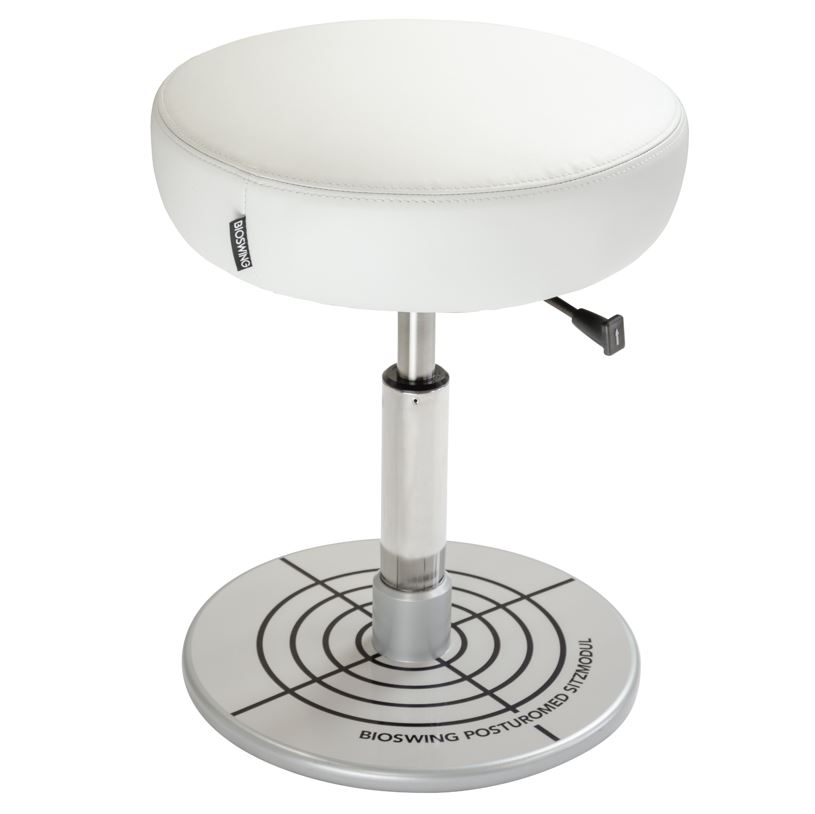
BIOSWING® sitting moduleThe seat module for the Posturomed® 202 or Posturomed® compact enables stabilisation exercises in a seated position and is particularly suitable for all patients who cannot stand on the Posturomed®. Reasons for this are, for example, acute traumas in the foot or knee area, operations or signs of old age (geriatrics).Advantages: Particularly suitable for patients who cannot stand Optimal use in orthopaedics after trauma or operations in the foot or knee area, in geriatrics, neurology Safe training and strain on the trunk and abdominal muscles The stool is attached to a disc which has pins on the underside. These pins are inserted into the hole circle of the therapy surface of the Posturomed® and the seat module is thus installed.The stool is height-adjustable and can thus be adjusted to the height of each patient.It is possible to swing on the seat module in the same directions as if the patient were standing on the therapy surface: Extension and flexion of the trunk, laterally, diagonally or in circumduction. This mainly works the trunk muscles and the (oblique) abdominal muscles of the patient.To make the exercises easier, all oscillation circuits of the Posturomed® should be open so that the oscillation amplitudes are greater.Product details: Scope of delivery: 1x seat module Easy to assemble due to plug-in connection Suitable for the Posturomed® 202 (from year of manufacture 2012, bolt circle must be available) and the Posturomed® compact Downloads: User manual

BIOSWING® feedback moduleThe feedback module for the Posturomed® 202 and the Posturomed® compact allows a more precise visual control of the vibrations of the therapy surface. This makes it easier for both the patient and the therapist to check whether certain exercises are being performed correctly or sufficiently.The feedback module consists of three red and three black plates. The black ones are attached to the vibrating surface on the front and both outer sides. The red counterparts are attached directly to the fixed part of the Posturomed® underneath the black plates. The black and red plates must each be installed so that they are exactly on top of each other.When the therapy surface vibrates during an exercise, the black plate also vibrates and you can see the "distance" to the red plate very well. This provides visual feedback on the movement and the direction of oscillation of the surface.The feedback module is useful to check the correct execution of exercises.Product details: Scope of delivery: 3x black plate, 3x red plate. Suitable for the Posturomed® 202 and the Posturomed® compact Note: The black plate is used with the provocation module to attach the oscillating surface in a deflected position.
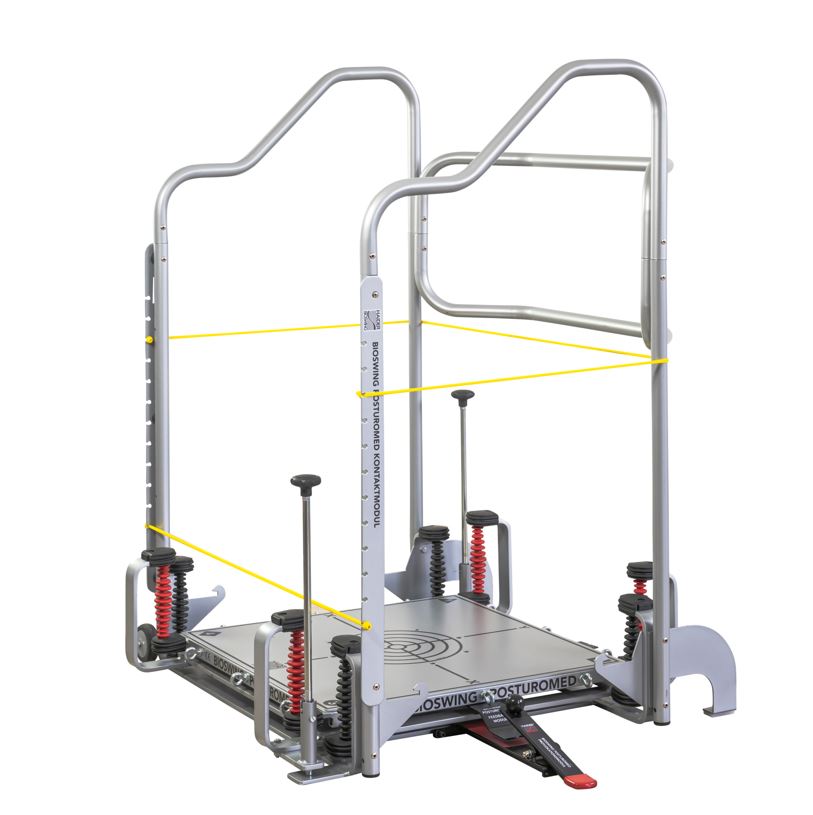
BIOSWING® Contact ModuleThe contact module is used to apply tactile stimuli and thus optimise the execution of exercises. It is also extremely helpful in combination with the rehabilitation module: When used appropriately, it generates additional resistance that significantly increases the range of exercises with the rehabilitation module.The contact module consists of two components: The two steel sheets are attached to the railing of the Posturomed® 202. The notches allow the rubber bands to be attached. A total of 4 rubber bands in two different lengths can be stretched as desired in and around the Posturomed® railing and attached to the notches of the steel sheets. The contact module offers these possibilities: Tactile feedback: The rubber bands can be used to control the range of movement during exercises. For example, the patient lifts his leg until his foot touches the band. Resistance (especially in connection with the rehabilitation module): If a long rubber band is stretched completely around the railing, it can provide additional resistance during exercises with the rehabilitation module. Example: higher resistance during movements into adduction, abduction, extension or flexion. Hurdle: The rubber bands can be attached at an appropriate height and serve as a hurdle, for example for a big step or a jump onto the swing surface. Product details: Scope of delivery: 2x steel sheets with notches, 2x long yellow rubber band, 2x short yellow rubber band. Optimal training possibilities in combination with the rehabilitation module Suitable for the Posturomed® 202 NOT suitable for the Posturomed® compact
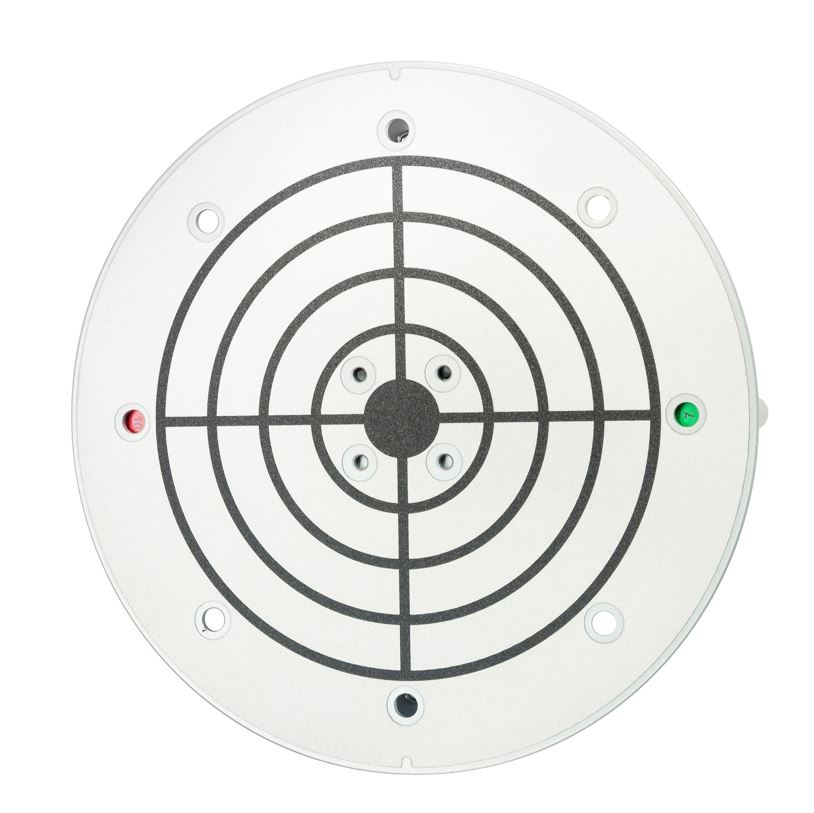
BIOSWING® OSG moduleThe OSG module for the Posturomed® enables demanding exercises that stress both the upper and lower ankle. The sensorimotor stimulating movement impulses of the Posturomed® swing surface are also used outside the horizontal plane.The OSG module is a round plate with a diameter of 32 cm that is attached to the bolt circle of the Posturomed® 202 or Posturomed® compact by means of a plug-in connection.The module has a tilting axis whose angle can be adjusted on the underside. Depending on the setting, the footprint tilts by 7, 10, 15 or 20 degrees.Depending on how the module is aligned, the axis tilts to the right/left, front/rear or diagonally.Depending on the orientation of the module or the patient's foot on the module, the ankle joints can be provoked in their different functional axes for their stabilisation ability. Such exercises place higher demands on the stabilisation of the upper and lower ankle joint and are therefore mainly suitable for advanced practitioners, for well-stabilised patients or for athletes. In addition, the OSG module is used in neuro-orthopaedic rehabilitation and orthopaedics.Advantages: Adds challenging exercises to the training spectrum. Offers another level beyond the horizontal swing surface Individual adjustment of the tilt angle to the individual patient Quick and easy installation via plug-in connection on the bolt circle Important: The adjustment of the tilt angle must always be adapted to the individual conditions of the patient. 7 degrees is the physiological maximum angle for medial and lateral gaping of the OSG. At 10, 15 or 20 degrees, on the other hand, there is a risk of overloading the capsular ligamentous apparatus of the OSG and USG if this is pre-damaged, e.g. after supination trauma.Product details: Scope of delivery: 1x OSG module Diameter of the standing surface: 32 cm Tilt angle of the standing surface varies between 7, 10, 15 and 20 degrees depending on the setting Installation by simple plug-in connection with the pitch circle of the Posturomed®. Suitable for the Posturomed® 202 and Posturomed® compact Downloads: User manual

BIOSWING® Provocation ModuleThe provocation module is an additional module for BIOSWING® Posturomed® 202 and compact.It enables recurring, exactly reproducible provocations to be administered to the patient.First, the provocation module itself is used to set whether the therapy surface is to be deflected by 10, 20 or 30 millimetres. Then the module is attached to the outside of the Posturomed®.In addition, both latches of the Posturomed® should be open so that the therapy surface can deflect by the corresponding 10, 20 or 30 mm.By means of the provocation module, the therapy surface is now deflected ("pushed to the side") and locked, i.e. "fixed". While the patient now stands on the therapy surface and, if necessary, performs a given exercise, the therapist can simply step on the outer part of the additional module. The therapy surface swings back to its starting or standard position in the middle and thus triggers a provocation. The patient has to compensate or stabilise this impulse.Depending on the patient's position on the therapy surface, the direction of the provocation also changes: For example, the muscles primarily used can be adductors, abductors, hip extensors or hip flexors.The advantage of the provocation module: The provocation impulses can always be reproduced exactly and the patient's reactions can be compared.Product details: Scope of delivery: 1x provocation module Deflection of the therapy area by 10, 20 or 30 mm Suitable for BIOSWING® Posturomed® 202 and BIOSWING® Posturomed® compact Note: If you also purchase a feedback module for your Posturomed®, only the red and black rocker switch is supplied. The black counterpart is then already included in the delivery of the feedback module. Downloads: User manual
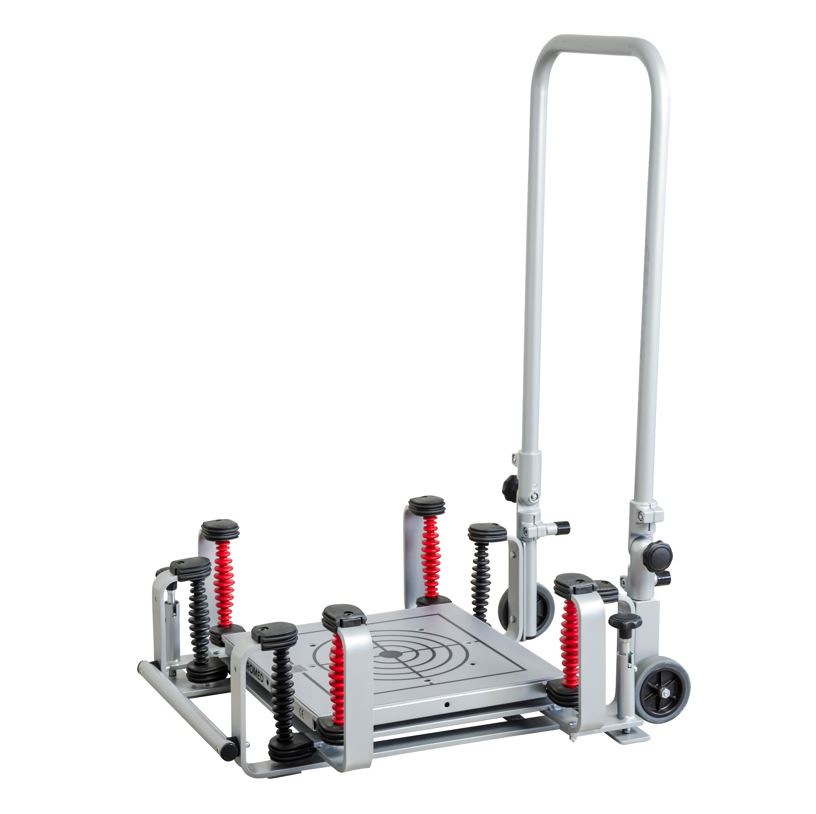
BIOSWING® Posturomed® compactThe BIOSWING® Posturomed® compact is the "little brother" of the BIOSWING® Posturomed® 202 and is suitable for the same exercises to improve coordination and stability.The BIOSWING® Posturomed® by HAIDER® is a sensorimotor device for prevention, therapy and diagnosis. The therapy surface, also called the "swinging surface", is suspended on a double swinging mechanism. This enables dosed, damped pendulum movements. The oscillation amplitudes can be set differently.Through the dosed provocation of motor control and regulation from the somato-sensory system in a closed movement chain on the BIOSWING® Posturomed®, an optimal quality of postural actions and reactions can be worked out. This activation of segmental, sectoral and polysegmental coordination serves to stabilise the weight-bearing joints and the spine. A stable sensorimotor system forms the basis of a pain-free and efficient movement system.When should I choose the BIOSWING® Posturomed® compact?The compact version of the BIOSWING® Posturomed® is particularly suitable when space conditions do not allow the stationary BIOSWING® Posturomed® 202 to be set up. With its therapy area of 40 x 40 cm, the BIOSWING® Posturomed® compact takes up less space. In addition, it can be folded up quickly and easily and put to one side. If it is needed, it can be set up quickly in just a few steps and is ready for use.The BIOSWING® Posturomed® compact is also suitable for anyone who wants to use it in different places. Whether in different wards in the clinic or therapy centre, or even on the road: this Posturomed® is easy to transport and fits in any car boot.The advantages of the BIOSWING® Posturomed® compact: Takes up less space Can be quickly folded up and put away Is perfect for mobile use as it can be easily transported Tip:If you have enough space for the BIOSWING® Posturomed® 202 and do not need it for mobile use, then we always recommend the BIOSWING® Posturomed® 202. With its larger therapy surface, it opens up more varied exercise options for you. It also has a 3-sided handrail (in contrast to the 1-sided handrail on the BIOSWING® Posturomed® compact), which ensures more safety for the patient. Furthermore, more additional modules can be attached than with the compact version.Differences to the BIOSWING® Posturomed® 202: Smaller therapy area: 40 x 40 cm instead of 60 x 60 cm Handrail on one side instead of 3 sides Lower weight: 27 kg instead of 42 kg Handrail can be folded in When folded, the BIOSWING® Posturomed® compact can be easily transported using the carrying handle and castors. Note:As the BIOSWING® Posturomed® compact and therefore also the therapy surface is smaller and lighter, the oscillation frequency is also slightly higher than with the BIOSWING® Posturomed® 202, resulting in a slightly more demanding situation for the patient.Product details: Therapy surface / swinging surface: 40 x 40 cm Weight: 27 kg Foldable support railing on one side Suitable for stationary and mobile use Class 1 medical device Certified according to MDR 2017/745 Downloads: BIOSWING® Posturomed® user manual
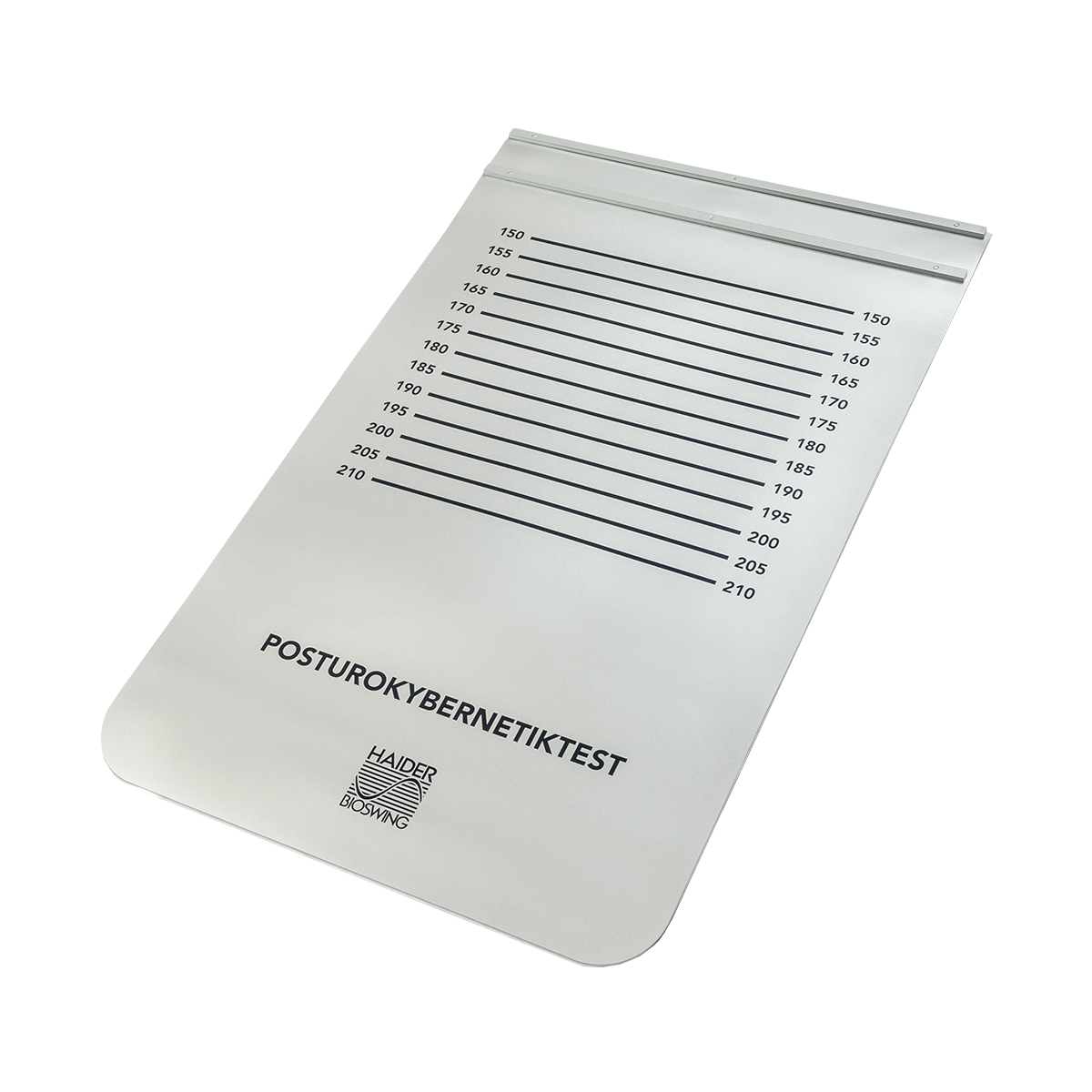
The BIOSWING® Step Mat PKT is an accessory for the Posturomed 202. The step mat, which can be securely locked in place in front of the Posturomed 202 with a steel rail, is used for standardised performance of the "PosturoCybernetics Test". In addition, this disinfectable plastic mat is also used in therapy with the Posturomed for all exercises that have their starting position in front of the Posturomed. For example, "step-up exercises" can be performed with a recurring, reproducible step length. Markings and body sizes are printed on the mat to help the exerciser position himself optimally on the BIOSWING® Posturomed 202. Training successes and training progress can be displayed and measured.
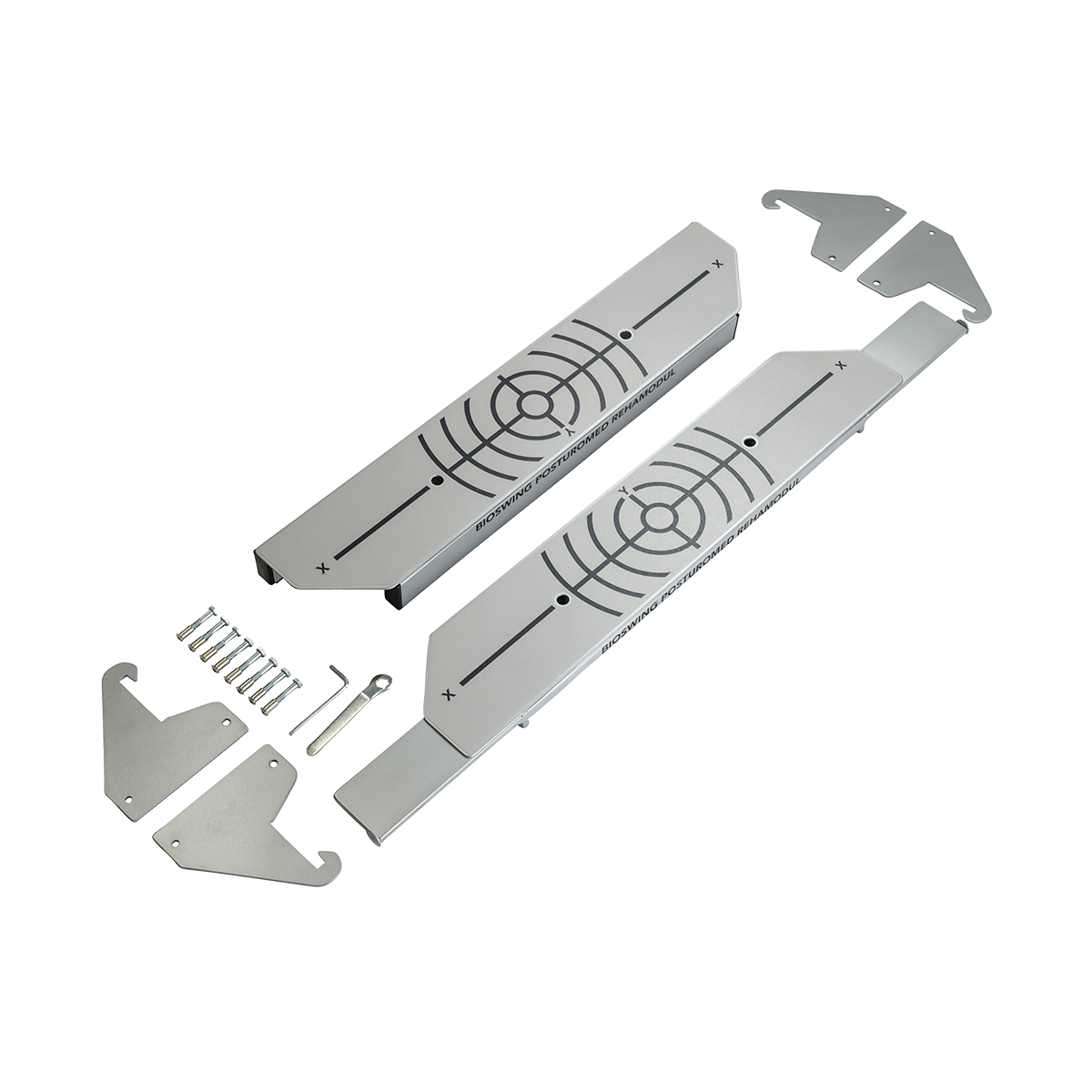
The BIOSWING® rehabilitation module is an accessory for the BIOSWING® Posturomed 202. It is used for directional stabilisation exercises on the Posturomed 202. With the rehabilitation module, which can only be connected to the Posturomed® 202, pelvic, knee joint and ankle joint stabilisation exercises can be carried out in a closed kinetic chain in higher frequency muscle synergism. Due to the possible partial relief of the lower extremities, the rehabilitation module can be used in an early rehabilitation phase. Once the rehabilitation module is mounted, it can be easily and simply attached to the Posturomed with the plug-in system. While the patient stands with one leg stable on the fixed element above the therapy surface (fixed point), the other leg stands unstable on the mobile element (mobile point), which is securely locked on the swinging therapy surface of the Posturomed®. With the help of the intervention traction or a cable traction device, the patient can additionally work against a resistance. For optimal use of the rehabilitation module, visual feedback on compliance with the directions of movement specified by the therapist is required: either via the feedback module (mechanical) or via MicroSwing measuring system (electronic).
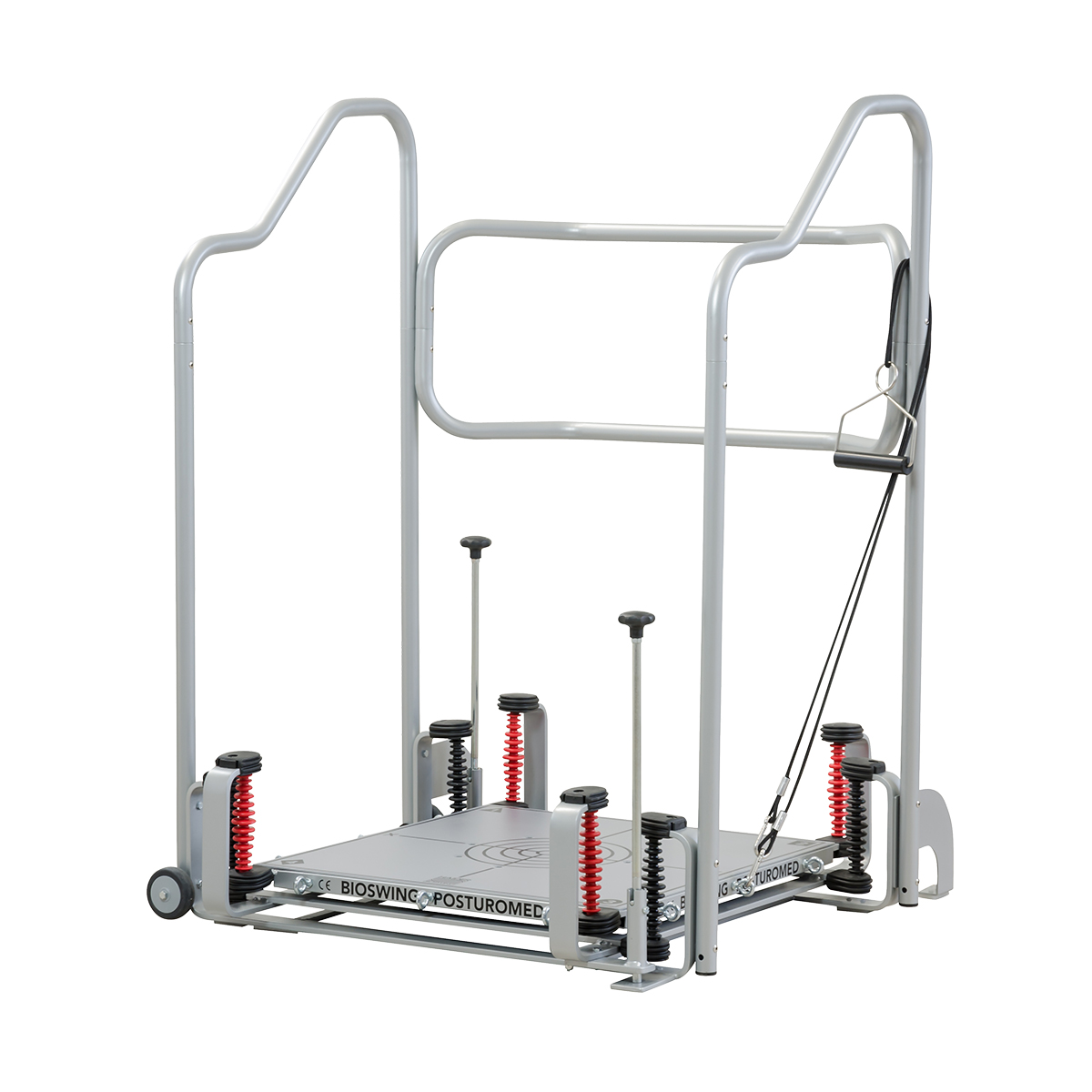
The Posturomed® 202 is the neuro-orthopaedic diagnostic, prevention and therapy device with a dosed damped unstable surface. This therapy surface is attached to special oscillating elements which allow dosed damped evasive movements in a certain frequency range and with differently adjustable vibration amplitudes. Due to the dosed increase of the proprioceptive, vestibular and optical afferences on the Posturomed® an optimal quality of postural actions and reactions can be worked out. This individually dosed Activation of the segmental, sectoral and polysegmental coordination serves the optimal stabilization of the supporting joints and the spinal column. A stable postural system forms the Basis of a painless and efficient movement system, especially for long lasting monotonous activities. The crosshairs located on the 60 x 60 cm therapy area with Circle centring enables the user to visually orientate himself during training. This identification enables standardised test procedures such as the PosturoKybernetikTest PKT. The enclosed intervention train enables on the one hand the manual calming of the therapy area by the therapist, on the other hand the targeted deflection of the therapy area for a reactive training. The Posturomed® 202 can be supplemented by numerous additional modules, which significantly expands its already large spectrum of indications. Approved as a medical device in the class 1.
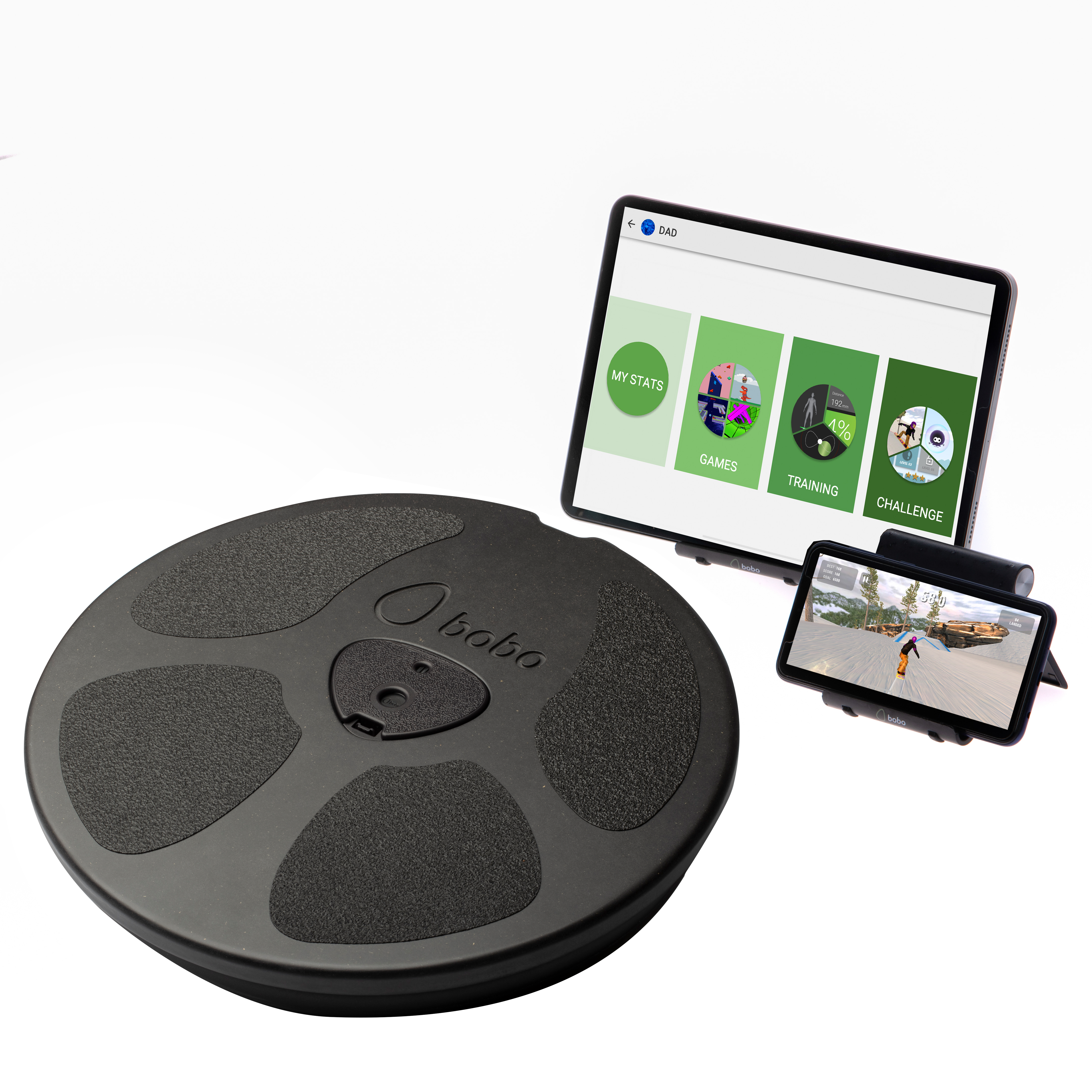
BoBo® Wobbly Playfully improve your balance & coordination! BoBo® Wobbly is a balance board that has a flat base on the top and a dome-shaped base on the bottom. The unstable base ensures that the board can tilt in all directions. Thus, your body is permanently challenged to maintain balance. It also improves coordination and posture. To make the exercises on the BoBo® Wobbly Balance Board fun, a sensor is integrated in the board, which transmits the movements of the board via Bluetooth to your smartphone or tablet. With the BoBo Home app, you then have the option of playing games or performing exercises. The BoBo Home App With the BoBo Home app, your balance exercise becomes a game! Choose one of the 14 games or try your hand at the exercise programs. The app also saves your results and graphs your progress. The app is free, with no hidden costs and no subscription period. Product details: Scope of delivery: 1x BoBo® Wobbly, 1x donut air cushion. Includes built-in Bluetooth motion sensor Including free app for iOS & Android Diameter: approx. 35 cm Anti-slip surface Max. Load: 150 kg Operation of the sensor with lithium button battery CR 2032, 3V Battery life: approx. 400 hours
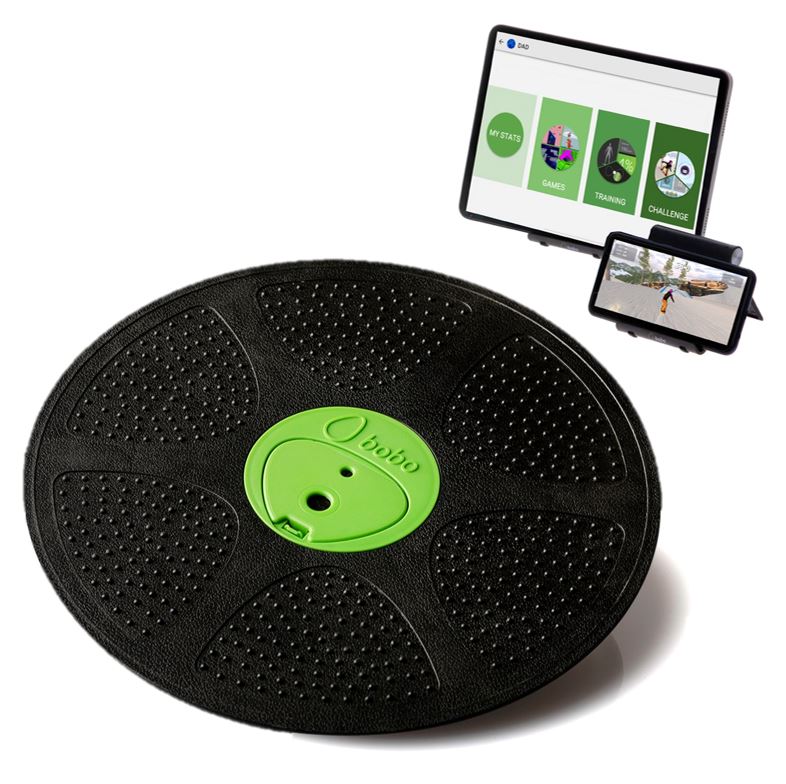
BoBo® Wobbly Playfully improve your balance & coordination! BoBo® Wobbly is a balance board that has a flat base on the top and a dome-shaped base on the bottom. The unstable base ensures that the board can tilt in all directions. Thus, your body is permanently challenged to maintain balance. It also improves coordination and posture. To make the exercises on the BoBo® Wobbly Balance Board fun, a sensor is integrated in the board, which transmits the movements of the board via Bluetooth to your smartphone or tablet. With the BoBo Home app, you then have the option of playing games or performing exercises. The BoBo Home App With the BoBo Home app, your balance exercise becomes a game! Choose one of the 14 games or try your hand at the exercise programs. The app also saves your results and graphs your progress. The app is free, with no hidden costs and no subscription period. Product details: Scope of delivery: 1x BoBo® Wobbly, 1x donut air cushion. Includes built-in Bluetooth motion sensor Including free app for iOS & Android Diameter: approx. 35 cm Anti-slip surface Max. Load: 150 kg Operation of the sensor with lithium button battery CR 2032, 3V Battery life: approx. 400 hours

BoBo® Pro 2.0The innovation: One movement sensor - many types of therapeutic exercisesWith just one sensor, BoBo® Pro 2.0 combines classic balance exercises, cycling and range of motion ("ROM") training with state-of-the-art gaming elements to guarantee therapy sessions that are REALLY fun. Whether you want to bring more motivation into physiotherapy, improve the performance of athletes or strengthen the concentration and self-confidence of children and young people: BoBo® is the optimal training tool.Training with BoBo® improves Coordination Reactivity Concentration Mobility / Flexibility Body tension Muscle strength Endurance The advantages of BoBo®: Motivation through fun Open up new, effective training opportunities for your patients and motivate them with fun and engaging games for every fitness level. Comprehensive therapeutic solutions BoBo® digitises all types of therapeutic exercises and tools to enable better therapy results and a more efficient practice. Measure results and adjust therapy With real-time biofeedback and advanced performance tracking, you can easily analyse a patient's progress and adjust their individual therapy plan as needed. Patient dashboardThe BoBo Pro 2.0 app is the link between the device and the patient. It contains predefined training programmes and 15 balance games. In addition, patient profiles can be created in the app, in which the results and analyses of the sessions are stored. Individual therapy and training goals can also be entered.BoBo® Balance BoardWith the Balance Board, the entire range of balance training is available to you. It is simply placed on a balance pad, ball cushion or other unstable surface and off you go.During the exercise, the patient's performance is recorded and mapped in real time and made available as an analysis after the exercise. This enables an objective assessment of the (therapy) progress and the training plan can be individually adapted to the current status.BoBo® movement sensorThe movement sensor, which is built into the Balance Board, can also be used separately: Using Velcro fasteners, it can be attached to arms or legs, for example, to perform a holistic ROM assessment or training, or to record cycling performance. Range of motion ("ROM"): For the range of motion module, the sensor is attached to the appropriate body part using Velcro straps. It is now up to the therapist and the training goal whether the movement should be limited or whether the patient should use the full freedom of movement. The settings can be made quickly and easily in the app. Cycling: For the cycling function, the sensor is attached to the upper or lower leg with the Velcro straps. It does not matter whether the patient is pedalling on a spinning bike or pedalling on a pedal trainer while sitting on a chair. As soon as the cycling app is switched on, the user finds himself in the middle of a virtual cycling track. And this is how it works: Simply download the BoBo Pro 2.0 app from the Apple Store or Google Play and connect your Balance Pad. Choose an exercise or game and start training!Product details: Scope of delivery: 1x balance board, 1x motion sensor, 3x velcro strap. Free BoBo Pro 2.0 app available for Android and iOS Connection of the devices with the smartphone via Bluetooth Maximum load of the Balance Board: 200 kg Dimensions of the Balance Board: approx. 40 cm x 30 cm Battery life: up to 400 hours

The new ski trainer is a dynamic and versatile training and therapy device. It can be used on both sides, is ideal to clean and easy to stack. The proven training device with the 2-chamber air system as an unstable base allows a training with maximum effect. The training goes more intensively into the depth, perception, stimulus processing and stability are trained and improved. Use of the Ski-Trainer: You can use the Ski Trainer on almost any surface. The design of the Ski Trainer ensures a safe contact with the ground. You should avoid using the Ski Trainer on a stony Subsoil (gravel, pebbles), as well as asphalt. You should avoid sharp objects or sharp edges in the area where the Ski Trainer is used, as these could injure the Ski Trainer. Product details: Colour: Red/black Weight: approx. 3840 g Load capacity: approx. 200 kg
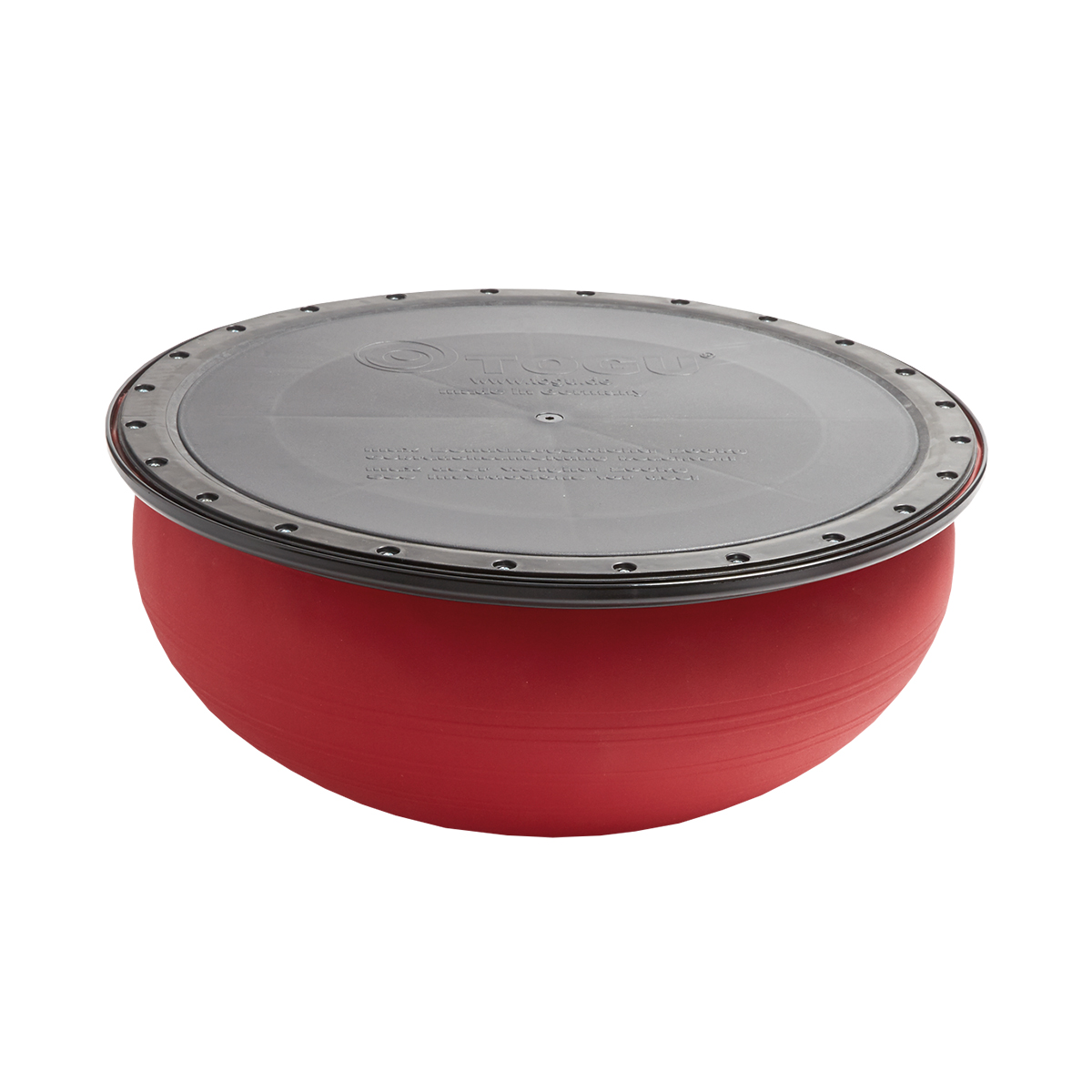
The original for even more versatile use. Now with the additional Jumper Pro Plate, which creates a flat surface on the back of the Jumper - made in Germany. The new plate is easily and quickly mounted with a supplied screw and also to be removed again. This way the different contact surfaces can be used during the training. With the new flat surface, balance, coordination, and training can be and strengthening exercises while standing, a physiologically correct positioning of the sole of the foot is possible. This results in even more exercise variations. In addition to the jumper, the delivery includes the Jumper Pro Plate including fixing screw and Allen key. DE patent number 2092964 and EU patent number 502008002725.4 Tested and recommended by the Forum: Gesunder Rücken - besser leben e.V. and the Federal Association of German Back Schools (BdR) e.V. Further information at: Action healthy back e. V., Stader Str. 6, D-27432 Bremervörde, www.agr-ev.de *If you have any complaints, ask your doctor or physiotherapist for advice before starting training. Product details: Dimensions: 52 x max. 24 cm Weight: 5.050 g Load capacity: approx. 200 kg
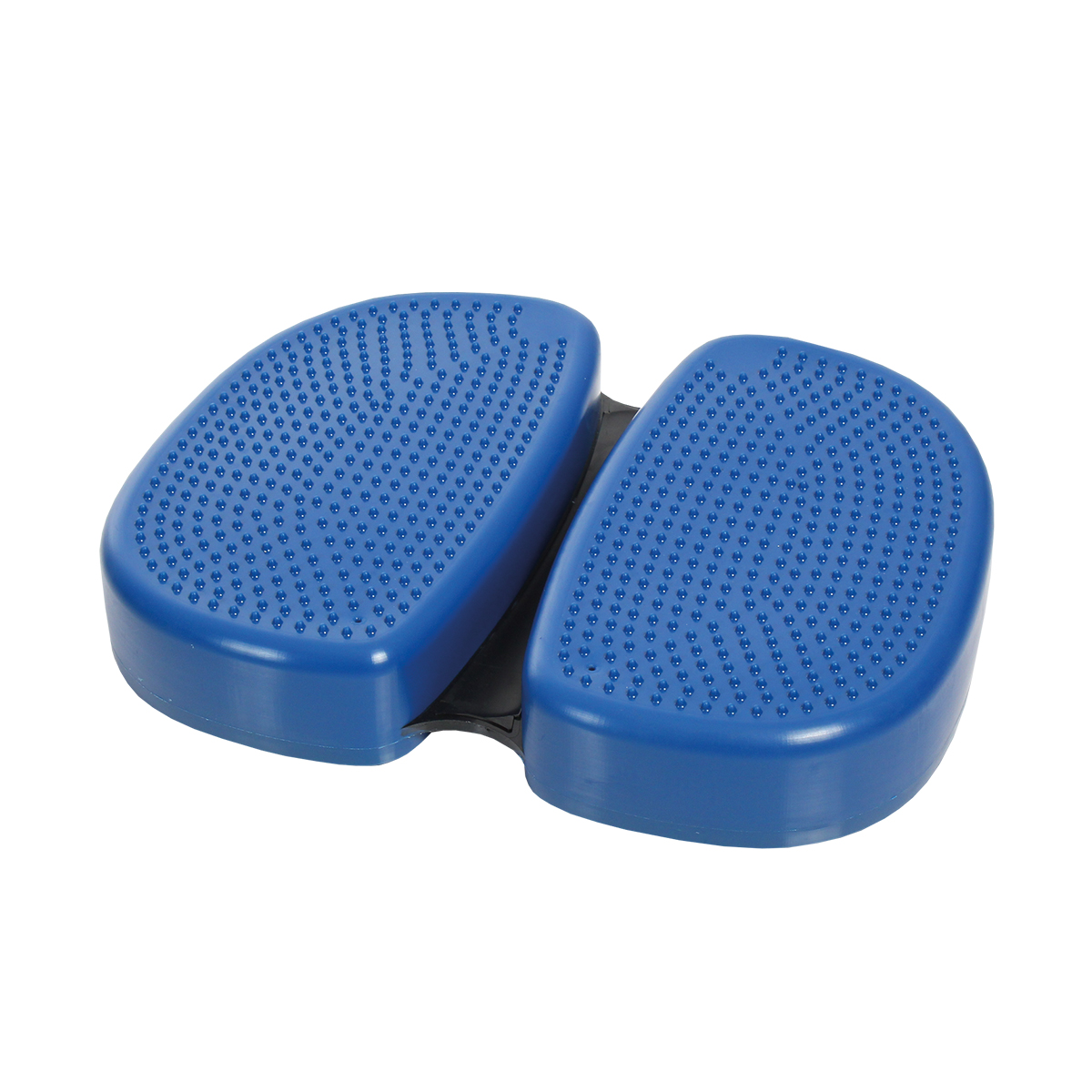
The new Aero-Step Pro - made in Germany - is more dynamic, larger and more versatile. It has one side with knobs and one side without. Therefore the Aero-Step Pro can be used on both sides - 2 in 1, ideal to clean - easy-clean and easy to stack - easy-store. Detailed exercise instructions and an air pump for individual adjustment are included. The proven leg axis trainer with the 2-chamber air system as a dynamic base allows a Training with maximum effect, especially in the area of foot and leg axis training. The training goes deeper, perception, stimulus processing and stability are trained and improved. The Aero-Step® Pro can be used in a standing, prone, lateral and supine position applicable. Equipped with approx. 1000 round pimples for massage and blood circulation. Suitable for therapy and rehabilitation, in fitness or at home. The Aero-Step® Pro is certified with the AGR seal of approval as particularly back-friendly. The Aero-Step® Pro is also available with the antimicrobially effective actisan finish. Technical data: Dimensions: 52x40x8,5 cm Weight: approx. 3.600 g Load capacity: approx. 200 kg Expert opinion of Dr. Christos Papadopoulos, rehabilitation and fitness trainer: "The Aero-Step is an apparative supplement that enables us to work more creatively and efficiently in the area of coordination, strength and flexibility training. It replaces bulky utensils that were used in the past. The uniqueness of the material allows a versatile use, not only in the indoor, but also (in football of larger Meaning) for outdoor training, whether barefoot, with running shoes or with a soccer shoe, due to its robust nature anything is possible. The Aero-Step is an integral part of our exercise repertoire and it is impossible to imagine life without it. For the exercises specific to the sport, it provides the professional footballer with a is a special challenge, because in combination with the ball, the Aero-Step gives the mostly boring coordination and stabi-training the special kick and the fun factor is enormous high (motivation)." Tested and recommended by the Forum: Gesunder Rücken - besser leben e.V. and the Federal Association of German Back Schools (BdR)
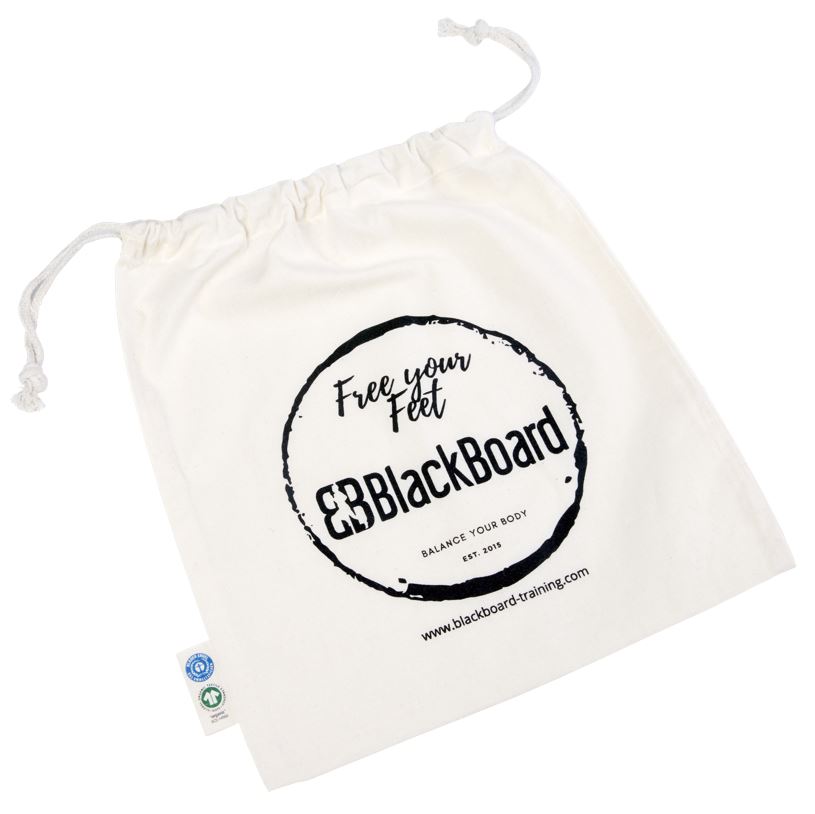
BlackBoard® BagThe BlackBoard bag is a stylish and tidy way to store your BlackBoard and accessories such as PerformanceBars, Mobilisatoin bars or ToeBands.
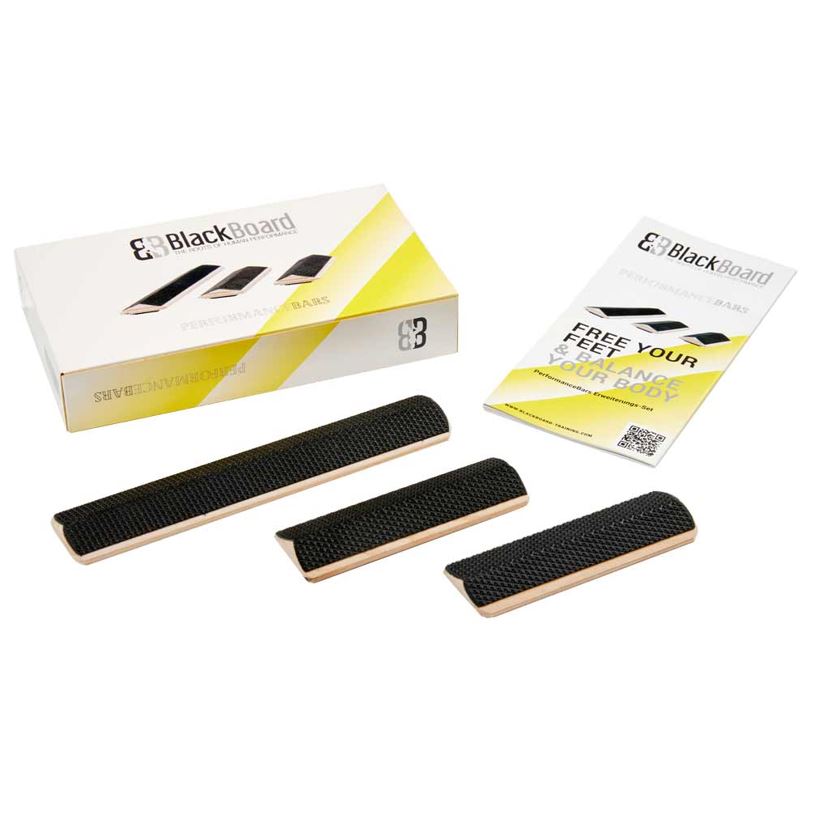
BlackBoard PerformanceBars The perfect extension set for all those who want to set their goals higher. The BlackBoard PerformanceBars offer you a new challenge during your workout thanks to their acute tilt angle. They promise a targeted improvement of motor skills and reflexes. Product information: Size: 9 x 2.5 x 1.5 cm Weight: 0,139 kg Material: wood with anti-slip surface Scope of delivery: 1x PerformanceBar long, 2x PerformanceBar short, manual (+videos) Made in Germany Attention: The PerformanceBars can only be used in combination with the BlackBoard Basic.
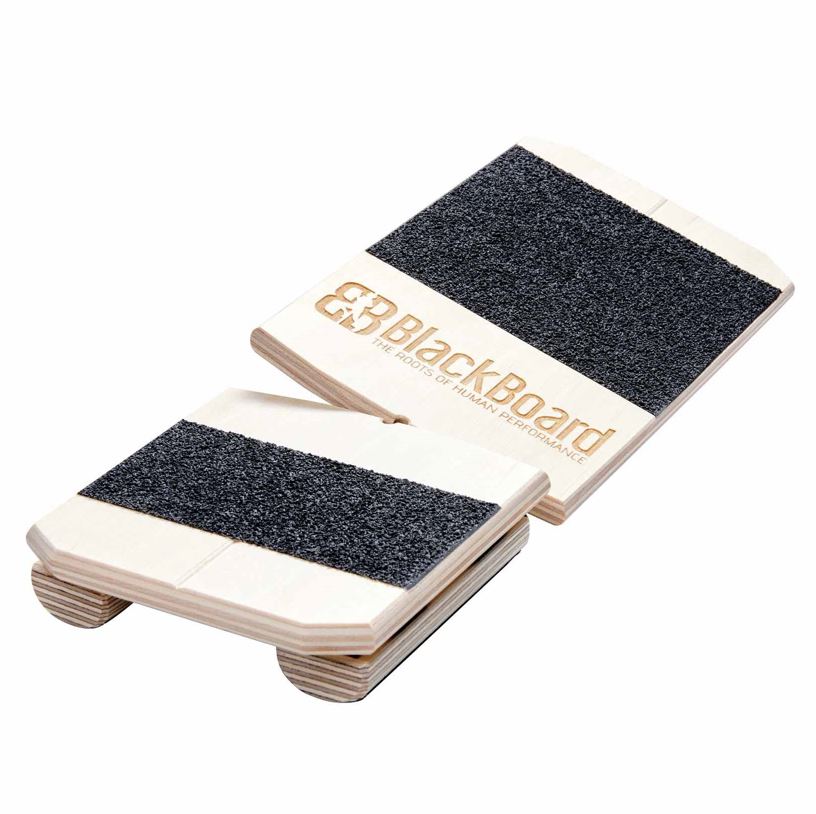
BlackBoard Basic Foot mobilisation with the first holistic training device With the BlackBoard Basic you have for the first time the possibility to treat your foot pain yourself, to strengthen neuronal connections or to get to the next level in sports. Simply stand on it and get started Thanks to two connected standing surfaces, specific movement patterns can be trained in a targeted manner. Thanks to freely adjustable rotation axes and self-selectable position of the standing feet, a holistic training of the foot as well as the neural connections is possible - and this independent of training progress and performance level. Your advantages: More stability, faster reaction, and better performance. Numerous exercises and videos "Modular principle": scope and intensity can be determined yourself Lightweight design can be used anywhere Expandable with different BlackBar sets Product details: Size: 24 x 17.5 x 3.5 cm Weight: 0,440 kg Material: wood with anti-slip surface Scope of delivery: 1x BlackBoard, 1x BlackBar long, 2x BlackBar short, manual (+videos) Made in Germany
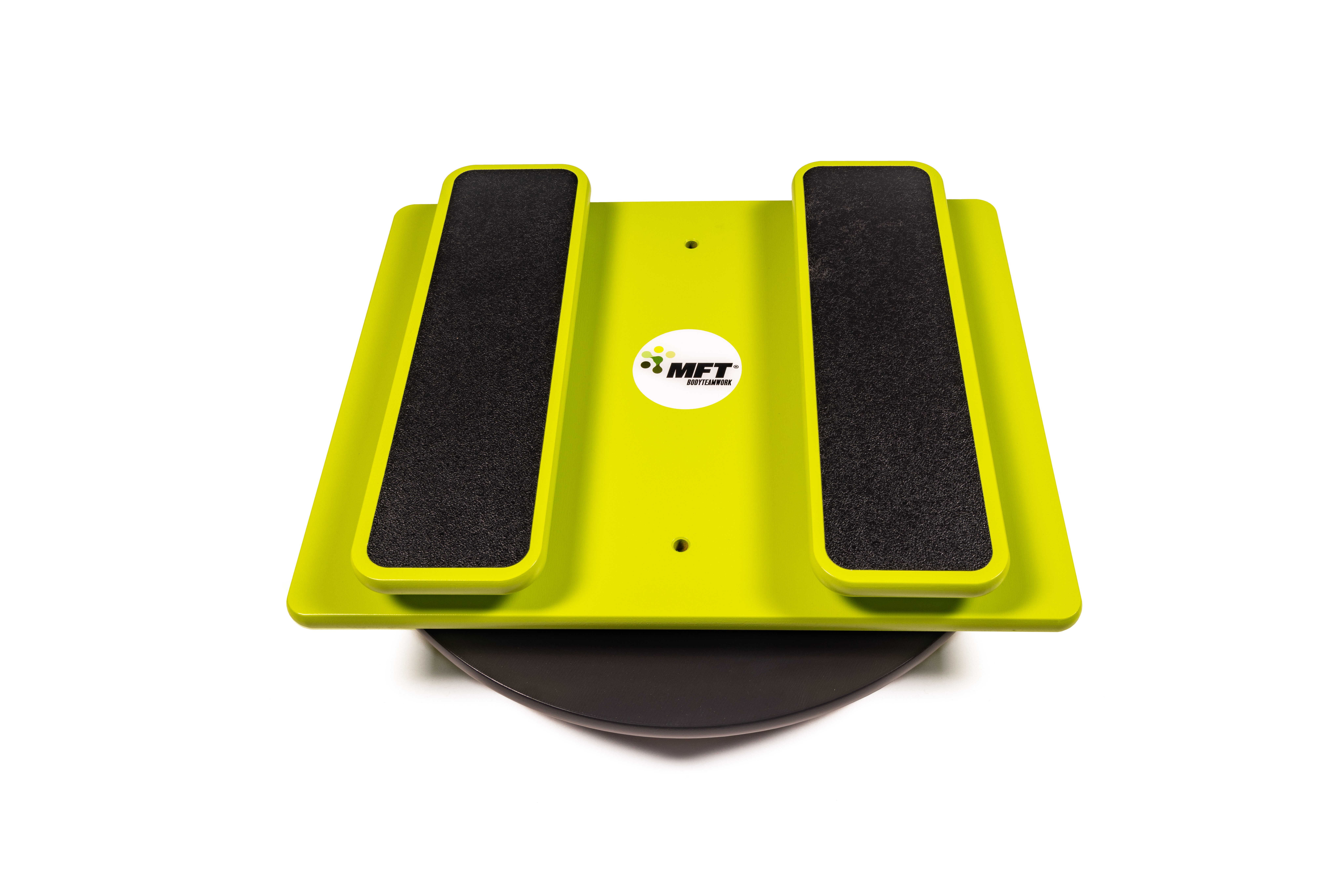
MFT® Pro Board 3D The multidimensional training device for ambitious athletes and professionals The MFT® Pro Board 3D is a versatile balance board designed specifically for advanced users. It enables multidimensional training to strengthen deep muscles and enhance performance in areas such as balance, strength, endurance, and fine motor skills. Additionally, it serves as optimal injury prevention and performance enhancement in elite sports. Main Features: Multidimensional Training: The Pro Board 3D combines a rocker, wobble board, and rotation disc in one device, allowing for comprehensive training of balance, coordination, and stability. Performance Enhancement: Through axis-aligned training, the musculoskeletal system is stabilized, significantly improving coordination and reaction time. Versatile Applications: Ideal for competition, sports, and therapy. Suitable for home training, personal training, fitness studios, physiotherapy, and performance centers. High-Quality Austrian Manufacturing: Produced under the highest environmental standards from recycled and renewable raw materials. Eco-friendly production utilizes solar power, and the durable construction ensures a long lifespan. Load Capacity: Suitable for users up to 120 kg (264 lbs), making it safe for both children and adults to train. Scope of Delivery: 1 MFT Pro Board 3D (Diameter: 50 cm, Height: 14 cm, Weight: 5.9 kg) Includes anti-slip surface for secure footing Side rockers and 2 brake stoppers for training adjustment 4 rollers for additional training variations User manual with exercises and tips Experience effective and challenging balance training with the MFT® Pro Board 3D that promotes your health while providing enjoyment.
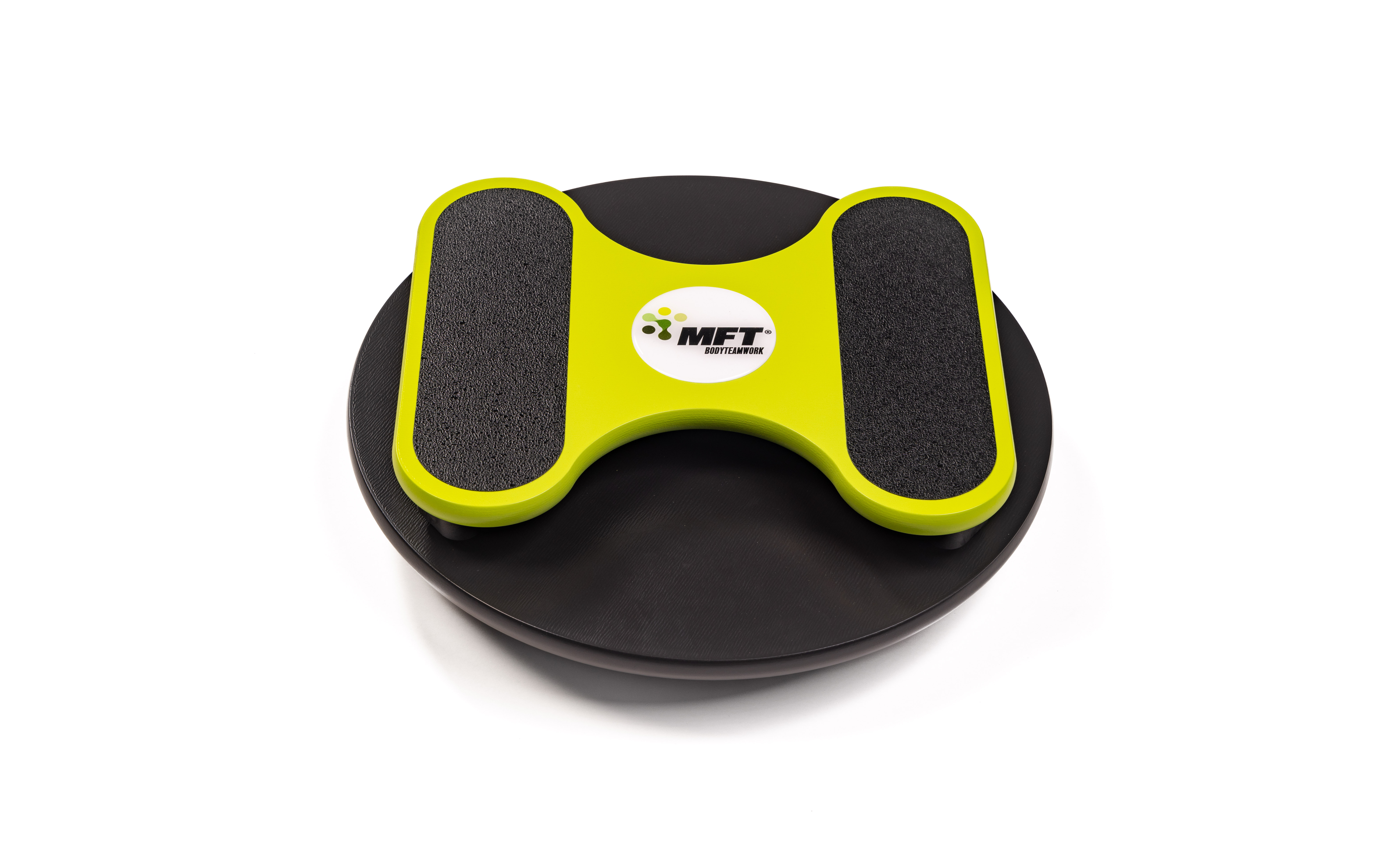
MFT® Pro Board 2D The ideal all-round device for therapy and sports The MFT® Pro Board 2D is a versatile training device designed for ambitious athletes and professionals. It enables multidimensional training to stabilize the musculoskeletal system and improve coordination. Through axis-aligned training, it promotes healthy ankle, knee, and hip joints, as well as a strong spine. Main Features: Multidimensional Training: Combines a rocker, wobble board, and rotation disc in one device, allowing for effective training of balance, coordination, and stability. Gradual Training Progression: Side brake stoppers allow for individual adjustment of difficulty levels, enabling progressive training. High-Quality Austrian Manufacturing: Produced under the highest environmental standards from recycled and renewable raw materials. Eco-friendly production utilizes solar power, and the durable construction ensures a long lifespan. Versatile Applications: Ideal for home training, personal training, fitness studios, and physiotherapy. Load Capacity: Suitable for users up to 120 kg (264 lbs), making it safe for both children and adults to train. Scope of Delivery: 1 MFT Pro Board 2D (Diameter: 40 cm, Height: 10.5 cm, Weight: 2.5 kg) Includes anti-slip surface for secure footing Side rockers and 2 brake stoppers for training adjustment 4 rollers for additional training variations User manual with exercises and tips Experience effective and challenging balance training with the MFT® Pro Board 2D that promotes your health while providing enjoyment.
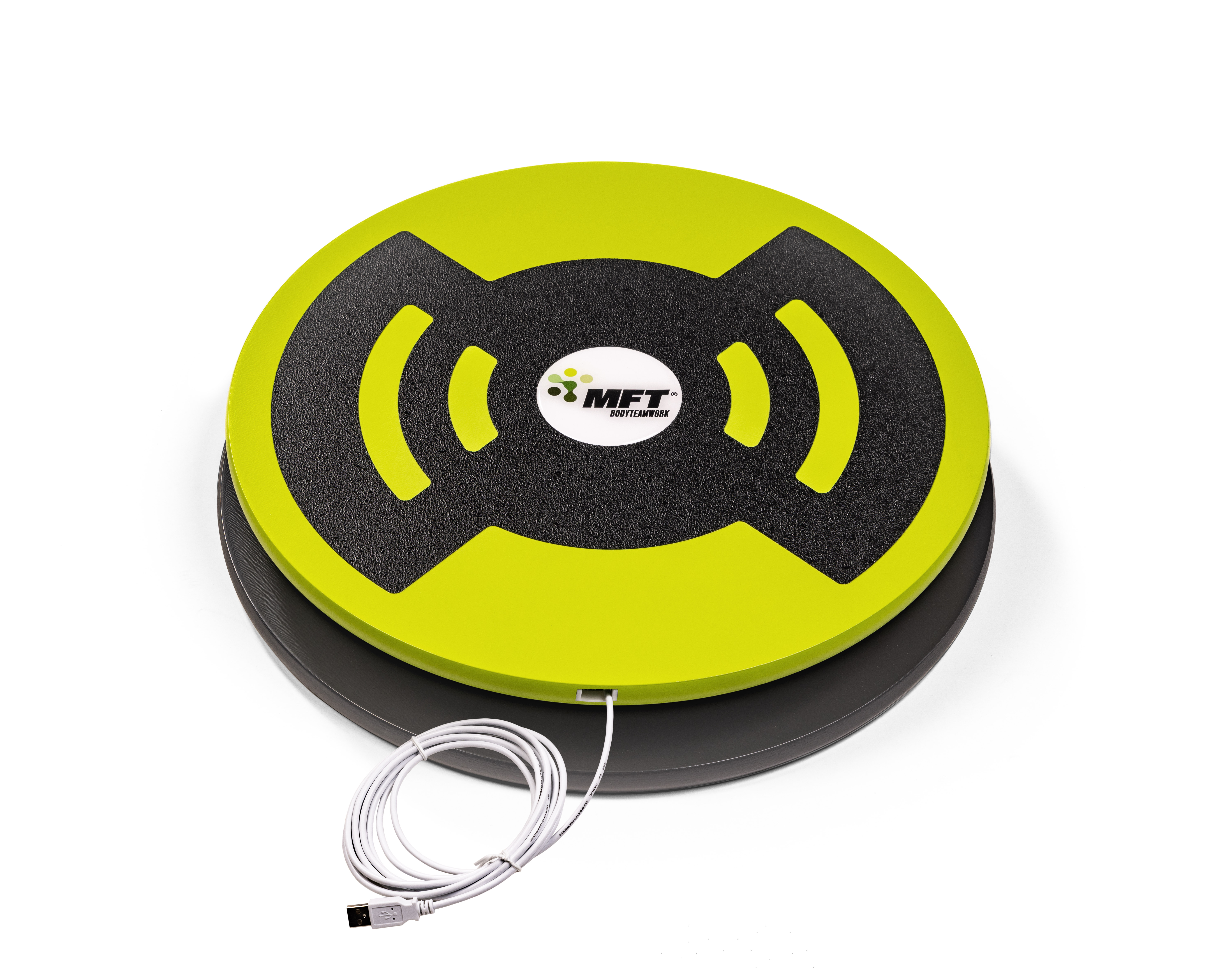
MFT® Challenge Disc USB The digital balance board for effective training and rehabilitation The MFT® Challenge Disc USB is an innovative balance board equipped with an integrated motion sensor that connects to your computer or laptop via a USB cable. It enables targeted coordination training with immediate feedback, making it ideal for home use, physiotherapy practices, rehabilitation centers, and high-performance sports facilities. Main Features: Interactive Training: Connecting to the MFT Bodyteamwork software allows for intelligent coordination training with real-time success monitoring. Various training programs and games make workouts engaging and measurable. Versatile Applications: Ideal for individuals who prefer training in a fixed location with a cable connection to their device, as well as for rehabilitation centers and physiotherapy practices with dedicated training or therapy stations. Health Benefits: Improves balance, stability, and coordination, aids in injury prevention, and effectively supports rehabilitation efforts. High-Quality Austrian Manufacturing: Produced under the highest environmental standards using recycled and renewable raw materials. Eco-friendly production utilizes solar power, and the durable construction ensures a long lifespan. Load Capacity: Suitable for users up to 120 kg (264 lbs), making it safe for both children and adults to train. Scope of Delivery: 1 MFT Challenge Disc USB (Diameter: 44 cm, Height: 7.5 cm, Weight: 3.6 kg) Integrated motion sensor with USB cable for connection to the MFT Bodyteamwork software Double-sided anti-slip surface for secure footing User manual with exercises and tips Experience effective and entertaining balance training with the MFT® Challenge Disc USB, enhancing your fitness while providing enjoyment.
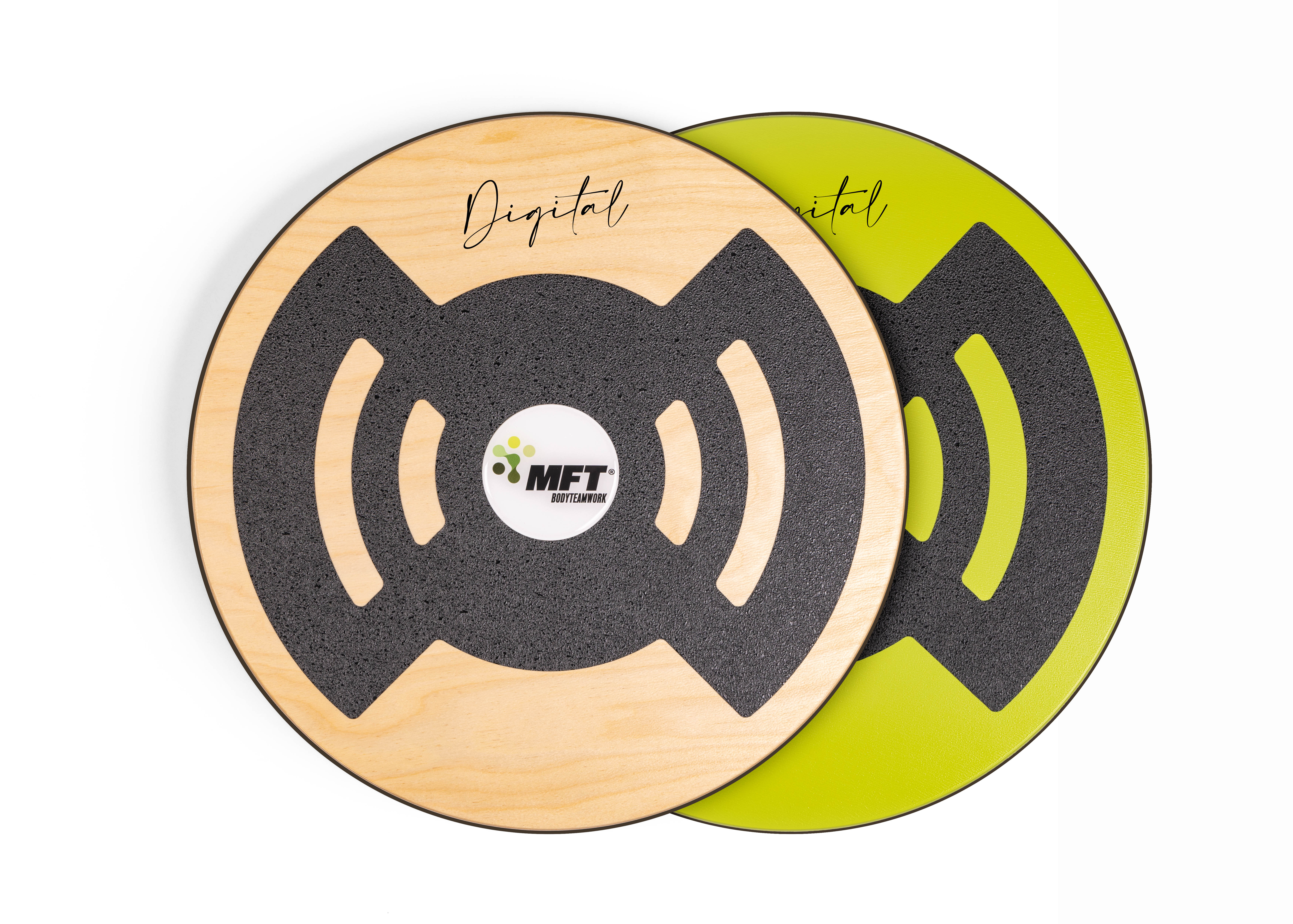
MFT® Challenge Disc Digital The smart balance board for ambitious athletes and the whole family The MFT® Challenge Disc Digital is an innovative balance board that, with the help of integrated motion sensors and the free MFT Bodyteamwork App, enables intelligent coordination training with immediate feedback. Training programs and games make workouts more engaging and measurable, allowing you to monitor your progress at all times. Main Features: Interactive Training: Connecting with the MFT Bodyteamwork App transforms the balance board into a digital trainer that detects and analyzes your movements. Versatile Applications: Ideal for home training, personal training, gyms, physiotherapy, rehabilitation centers, and clinics. Suitable for all age groups and fitness levels. Health Promotion: Improves balance, stability, and coordination, aids in injury prevention, and effectively supports rehabilitation. High-Quality Austrian Manufacturing: Produced under the highest environmental standards from recycled and renewable raw materials. Eco-friendly production uses solar power, and the durable construction ensures a long lifespan. Load Capacity: Suitable for users up to 120 kg (264 lbs), making it safe for both children and adults to train. Scope of Delivery: 1 MFT Challenge Disc Digital (Diameter: 44 cm, Height: 7.5 cm, Weight: 3.6 kg) Integrated motion sensor for connection with the MFT Bodyteamwork App Double-sided anti-slip surface for secure footing User manual with exercises and tips Experience effective and entertaining balance training with the MFT® Challenge Disc Digital that enhances your fitness while providing enjoyment.

MFT® Challenge Disc Classic The classic among balance boards The MFT® Challenge Disc Classic is the ideal training device for those who regularly want to work on their balance, stability, and coordination. It helps to enhance health and performance, improve balance, coordination, and stability, and serves as injury prevention while effectively supporting rehabilitation. Main Features: Effective Training: Promotes joint mobility and surefootedness, increases coordination and balance, relieves tension, and boosts strength, endurance, and fine motor skills. Versatile Use: Suitable for home training, fitness studios, corporate fitness, physiotherapy, rehabilitation centers, and clinics. For All Age Groups: Ideal for fitness and health-conscious individuals of all ages and performance levels. High Quality: Manufactured in Austria from recycled and renewable raw materials under the highest environmental standards. The eco-friendly production uses solar power, and the durable construction ensures a long lifespan. Load Capacity: Suitable for users up to a weight of 120 kg (264 lbs), making it safe for both children and adults to train. Scope of Delivery: 1 MFT Challenge Disc Classic (Diameter: 44 cm, Height: 7.5 cm, Weight: 3.6 kg) Includes anti-slip surface for secure footing User manual with exercises and tips Experience effective balance training with the MFT® Challenge Disc Classic that promotes your health while providing enjoyment.

MFT® Fun Disc Digital The smart balance board for the whole family The MFT® Fun Disc Digital combines interactive training with cutting-edge technology to enhance your fitness and coordination. With its integrated motion sensor and the free MFT Bodyteamwork App, this balance board becomes your personal trainer at home. Main Features: Interactive Training: Connecting with the MFT Bodyteamwork App enables intelligent coordination training with real-time feedback. Various training programs and games make workouts engaging and measurable. Versatile Applications: Ideal for beginners, recreational users, and children. Perfect for home training, personal training, gyms, physiotherapy, and rehabilitation centers. Health Benefits: Improves mobility, coordination, and joint stability. Aids in injury prevention and enhances strength, endurance, reaction time, and fine motor skills. High-Quality Austrian Manufacturing: Produced in Austria under strict environmental standards using recycled and renewable materials. Eco-friendly production powered by solar energy ensures durability and longevity. Load Capacity: Suitable for users up to 100 kg (220 lbs), making it safe for both children and adults. Scope of Delivery: 1 MFT Fun Disc Digital (Diameter: 40 cm, Height: 12.5 cm, Weight: 1.9 kg) Integrated motion sensor for connection with the MFT Bodyteamwork App Double-sided anti-slip surface for secure footing User manual with exercises and tips Experience effective and entertaining balance training with the MFT® Fun Disc Digital, enhancing your fitness while providing enjoyment.
What should I look for when buying a balance board
In the next section, we'll tell you which criteria are important if you want to buy a balance board and what you should consider when making your choice.
Size
The larger the surface area of the balance board, the more you can vary your stance and walking distance. Balance boards with a larger diameter are particularly suitable for beginners. Small balance boards are ideal for advanced users, but also for children (due to their height).
The higher the standing surface is from the ground, the more unstable the board is and the more difficult it is to keep your balance.
Material
Wood, rubber or plastic: it all depends on your personal preference. With wooden balance boards and wobble boards, however, you should make sure that you place a mat underneath. Exercise mats are particularly suitable for a firm grip. A non-slip base protects both the floor and you, as wooden balance boards can slip more easily than rubber or plastic models. This way you can avoid falling during your balance board exercises.
Surface
Balance board with studs or without? The surface structure also depends solely on your preference. You should just make sure that you have as stable a grip as possible. Dimples provide additional stimulation to the foot reflex zones when you use the balance board barefoot without shoes, and they prevent you from slipping off the board. However, if you want to learn to surf with a wobble board, for example, a smooth board is best.
Who are balance boards suitable for?
Balance boards have their origins in physiotherapy. They are very suitable for strengthening the sense of balance and deep muscles and for training coordination and motor skills. In rehabilitation and physiotherapy, balance boards are often used to rebuild muscles or strengthen joints. They are training devices for young and old, beginners and advanced users, it just depends on the model or the variant in which they are used.
What is the best way to get on a balance board?
If you are new to balance training, we advise you to hold on to the wall, a solid, stable object or your training partner so that you don't fall over when you step onto the board. How else can you get on a balance board? You should step onto the models with a half ball cushion with your feet one after the other and as centrally as possible. Then you can carefully widen your stance by moving your feet outwards on the ball with small movements.
Which balance board is right for me?
Round, square, made of wood, plastic, with Bluetooth function or a balance board with wheels. There is a wide range of different models among the wobble boards. We explain the differences here and help you find the right balance board - whether it's a beginner's model or a wobble board for advanced users.
Balance boards for beginners
Balance spinning tops, also known as balance discs, are particularly suitable for beginners. They consist of an air-filled base, usually a ball or half of a ball, and a tread plate, like the MFT Fun Disc. Balancing on the MFT Fun Disc not only trains your sense of balance - it also requires coordination. The MFT Fit Disc is also ideal for beginners: An additional disk is attached to the underside of the balance spinning top, so you have a firmer footing and have to balance less than on the MFT Fun Disc.
The Togu Aero-Step Pro is a good alternative for those who don't want to balance on a central surface. It has one smooth side and one side with nubs, which also stimulates the foot reflex zones. The chambers are filled with air and provide a dynamic surface on which to train the stability of the foot and leg axis in particular.
The Togu Balanza Ballstep is also a balance board for all fitness levels and offers beginners a good way to get started with sensorimotor training. Thanks to the four balls under the wooden wobble board, the standing surface is dynamically unstable. This intensively exercises the fine motor skills and deep muscles.
Balance Boards for pros
This is "next level" balance training: balancing on wobble boards with removable and/or rotating elements, such as the MFT Trim Disc and the MFT Sport Disc. The Trim Disc consists of a balancing disc with 2 rails on the underside and a module on rollers for the feet, which rotates on its own axis and can be fixed in any position. The Sport Disc has a large base plate on the balancing disc to which two removable tilting boards are attached. This modular design enables sport-specific training.
Foot trainer
Foot health is particularly important to the manufacturer BlackBoard: they have developed a special foot trainer, the BlackBoard Basic, with which you can counteract blockages or impaired mobility in the tarsal bones. The tilt angle and direction of movement of the two connected standing surfaces can be adjusted as required using wedges. This allows you to specifically train and mobilize your foot muscles. The BlackBoard Basic can be extended with different wedge sets: the PerformanceBars (with acute tilt angles) and the MobilisationBars (even higher wedges).
Wobble board for physiotherapy with app analysis
Would you like to measure your patients' training or therapy progress in terms of balance and equilibrium? Now you can! With the MFT Challenge Disc 2.0, the balance board with Bluetooth transmits the measurement data to the analysis app. This allows you to check and specifically train coordination, balance and any imbalances between the left and right side. You can also play games on the board thanks to the feedback function via the app.
Balance boards when learning to surf
The MFT Trim Disc is an ideal balance board for surfing beginners. Thanks to the numerous modules, you can adjust the wobble board so that it comes close to surfing on the water. Balancing on the MFT Sport Disc is even easier than on a balance board made of two parts, as there are also balance boards for learning to surf that consist of a roller and a board that are not connected to each other.
Togu Balance Boards: Jumper, Ski-Trainer & Dynair Walker
The star among balance trainers: the Togu Jumper Pro. It is probably one of the best-known balance boards and can be found in numerous fitness studios and practices for good reason. More precisely, the Togu Jumper is a balance board with a standing surface: placed on the flat surface, you can perform your balance exercises on the dynamic surface of the air-filled hemisphere. This reduces the risk of losing your balance during training, which is why this side of the Togu Jumper is also perfect for beginners. If you turn it onto the uneven surface, its 25 cm height makes it more of a balance board for advanced users. As the name suggests, you can simulate skiing with the Togu Ski-Trainer. But the balance board can do even more: thanks to the unstable surface, it is a great addition to any full-body workout. With the Togu Dynair Walker, walking becomes like dancing on eggshells. The air cushion shoes are designed to strengthen ankle joints and improve their stability.
